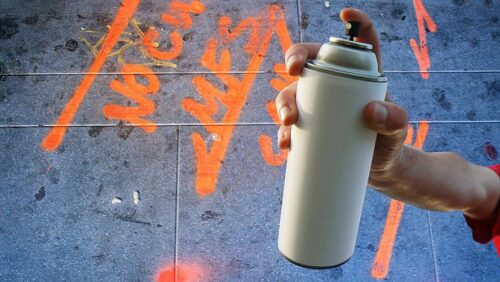7.6.23 – KEEL

Have you ever passed a bunch of brightly colored spray paint scribbled in the road, or on a sidewalk, and wondered what they mean? These florescent hieroglyphics actually represent some really important information.
Markings on streets, sidewalks, and on soil are generally placed there because of upcoming work. Sometimes its for new construction, sometimes its for repairs, but no matter how big or small a project may be, marking it is extremely important.
The importance comes from what is buried below us. Just like most of the United States, Louisiana has thousands of miles of underground gas lines, electrical lines, telecommunication lines, and water lines. Because of how dangerous these can be to those doing the work, and for those around them, marking these utilities are extremely important.
Decoding Utility Marking Symbols with STREETDOG Paint
The importance is recognized nationally, which is why the American Public Works Association created a universal code for paint colors to mark these. The color coding is used from New York to California, from Michigan to Louisiana. This is important for everyone involved. If a utility or construction worker travels from one state to another for work, having the same uniform code keeps them, and those around them safe. Additionally, residents have to mark their property when they are personally doing a project that involves any kind of digging. So if you just moved to Louisiana and want to install a fence, you would have to call 811 and have your property marked. The color coding of those marks would be the same as the markings from whatever state you just relocated from.
Check out the color coding below:
Why Do Utility Markings Have Different Paint Colors?
White Paint
White paint is used to mark proposed excavation projects. Either paths that projects will take, or the proposed area of work.
Green Paint
Sewer and drainage. While these markings generally don’t indicate potentially lethal accidents during projects, you still want to really avoid rupturing a sewage line…for obvious reasons.
Pink Paint
Pink is usually used to create boundaries. Even if temporary during a project, this helps keep things neatly in property lines.
Purple Paint
While the first reaction of many to purple paint might be “turn around, this is private property”, purple pain in the world of utility markings means non-potable water. This isn’t drinking water, this includes reclaimed water, irrigation water, and slurry lines. So while a rupture wouldn’t cut off drinking water, its still gonna make a mess.
Blue Paint
Sometimes the color code for utilities matches up with what’s being marked. Like blue represents drinking water lines. Blue being water just makes sense. Unlike the non-potable water lines marked with purple, rupturing the lines marked with blue will take out drinking water service to an area.
Red Paint
The way blue paint markings match up with water, red matches up too. But this time, red is the universal sign for STOP. Because red paint marks electrical utilities. This includes electric power lines and cables. Contact with these could be fatal.
Yellow Paint
Yellow is a major caution, and challenges the red paint markings for the most dangerous. Yellow paint marks natural gas lines, or other gaseous or flammable material. This is just as deadly as the electrical lines that red paint marks, but gas lines can actually end up doing far more property damage if ignored.
Orange Paint
Orange is used to represent communication lines. This could be telephone, fiber optic, or alarms. Some of these may carry electrical charges, but the bigger overall concern is how far the damage could reach. With how dependent our society is on communications, damage could impact a large number of people and businesses.
